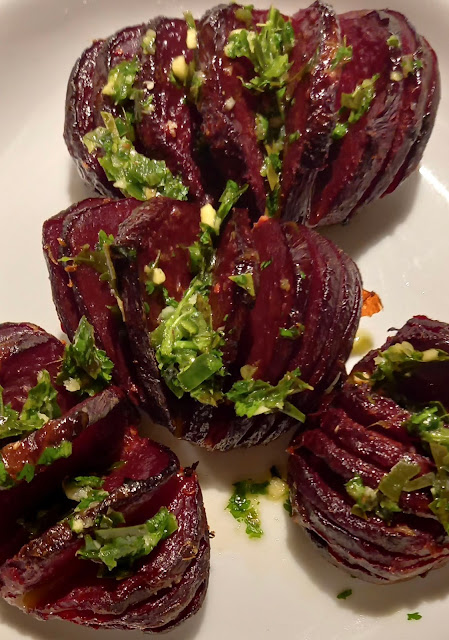Bringing hasselback
 |
| Hasselback beetroot with lime leaf butter |
The Vikings have produced many of my favourite potato dishes and so I decided to bring this long standing association of two culinary diverse cultures together with a bit of Scandinavian culinary skullduggery. Include a classic Portuguese staple, the anchovy, and the result is a simple recipe that I owe big time to Jansson, whoever he was. Fast forward to 2021 and it seems that the Hasselback method is definitely having a moment. And while potatoes may be the ultimate classic Hasselback, and dont get me wrong I revere the noble potato,in all its forms, from chips to mash, and roast to hash, this method is perfectly suited for a variety of other foods, including beets!I have taken Ottolenghi´s hasselback beetroot with lime butter ( top ) as an example example.His way with beetroot,from his book Flavours is packed with punch.
Hasselbacken Jannson
This simple recipe transforms the humble spud into a delicious, perfect baked potato with just 5 ingredients
25g butter
2 medium onions, very finely sliced
4 medium, waxy potatoes (about 800g), thinly sliced
284ml carton double cream, made up to 300ml with milk
1 large russet, baker, or red potato per portion
2 tablespoons dry bread crumbs
1 tablespoon melted butter
Preheat the oven to 200°C/fan180°C/gas 6. Drain the anchovies, reserving their oil. Gently heat half the butter in a saucepan and stir in the anchovy oil as it melts. Add the onions and fry over a low heat until they are very sweet – don’t let them brown. This should take a good 20 minutes. Once cooked, set aside.
Scrub your potatoes until good and clean.Using a sharp knife, make slices across the potato, being sure to stop before you reach its bottom. If you’re scared of cutting too far, a good technique is resting the potato between two wooden chopsticks. The chopsticks will actually prevent you from going too far!Next, open the potatoes’ crevices and with a teaspoon carefully insert dollops of the anchovy onion mixture into every other crevice,followed by some cream.When you have filled all the alternate crevices,mix bread crumbs together with the melted butter, then sprinkle over the top of the potatoes.
Hasselback beetroot with lime leaf butter
To offset the extra work, start with shop-bought ready-cooked beetroots (plain, not in vinegar).
Serves 4 as a side
or 8-10 ready-cooked beetroots (1kg)
Flaked sea salt
For the lime leaf butter
90g unsalted butter
40ml olive oil
5 fresh Kaffir or Makrut lime leaves, chopped
10g fresh ginger, peeled and chopped
1 garlic clove, crushed
1 tbsp lime juice, plus 2 tsp to serve
10 fresh Kaffir or Makrut lime leaves, stalks removed and very finely chopped
½ tsp fresh ginger, peeled and very finely chopped
½ garlic clove, crushed
½ green chilli, very finely chopped (deseeded for less heat)
1 tbsp coriander leaves, chopped
3 tbsp olive oil
Heat the oven to 220C (200C fan)/ 425F/gas 7. Place the beets in a baking dish in a single layer. Fill with water to 2cm up the sides, sprinkle on one tablespoon of salt, cover tightly with foil and bake for one hour and 20 minutes, or until a knife goes through easily. Discard water and, when cool enough, peel off the skin under cold running water (wear gloves to avoid staining). Halve larger beetroots lengthways. Reduce oven temperature to 190C.
While the beetroots are cooking, put the butter, oil, lime leaves, ginger and garlic into a small pan on a medium-high heat. Gently cook until the butter begins to bubble, about four minutes, then set aside to infuse for at least 40 minutes. Discard the aromatics, then stir in one tablespoon of lime juice and one teaspoon of flaked salt.
For the salsa, mix all the ingredients in a small bowl with a quarter-teaspoon of flaked salt, and set aside.
Cut slits in the peeled beetroots at 4mm intervals, stopping about 1cm from the bottom. Place on a small parchment-lined baking tray and fan the slices out. Spoon the melted butter evenly over, especially between the slices. Roast for one and a quarter hours, basting very well every 20 minutes or so, until the edges are crisp and caramelised. Set aside to cool for 15 minutes.




Comments
Post a Comment